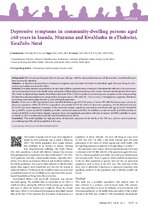Depressive symptoms in community-dwelling persons aged≥60 years in Inanda, Ntuzuma and KwaMashu in eThekwini, KwaZulu-Natal
Date
2015Author
Chipps, Jennifer
Narainsamy, Jayalakshmi
Cassim, Bilkish
Metadata
Show full item recordAbstract
BACKGROUND. Physical and psychological ailments increase with age; while the physical ailments are well documented, mental health issues
have received less attention.
OBJECTIVE. To determine the prevalence of depressive symptoms and associated risk factors in individuals aged ≥60 years living in a lowresource
peri-urban area in South Africa.
METHODS. Secondary analysis was performed on data obtained from a primary study conducted to determine the influence of socioeconomic
and environmental factors on the health status and quality of life in older persons living in the Inanda, Ntuzuma and KwaMashu (INK) area.
The Center for Epidemiologic Studies Short Depression Scale (CES-D 10) was used to screen for depressive symptoms in the week preceding
the interview, and respondents were categorised as having no (score <10), mild (10 - 14), or severe (>14) depressive symptoms. Risk factor
associations were tested using Pearson’s χ2 tests and logistic regression.
RESULTS. There were 1 008 respondents (mean (standard deviation) age 68.9 (7.4) years), of whom 503 (49.1%) did not meet criteria for
depressive symptoms. Of the 505 (50.1%) respondents who met the CES-D 10 criteria for depressive symptoms, 422 (41.9%) had mild and
83 (8.2%) had severe depressive symptoms. In the univariate analysis, significant associations were found with age (p=0.011), household
size (p=0.007), income (p=0.033), disability (p=0.001), nutritional status (p≤0.001), the inability to count on family (p=0.008) and lack of
mastery (p≤0.001). In direct binary logistic regression, there were significant associations with lack of mastery (p≤0.001), inability to count
on family (p=0.027), malnutrition (p≤0.001) and household size (p=0.024).
CONCLUSION. This study highlights the high prevalence of depressive symptoms in the elderly in the INK area, and the need to promote
successful ageing of the elderly population in this area.

